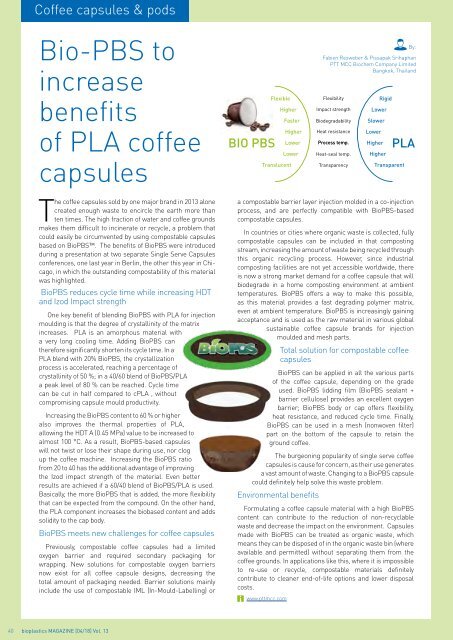Issue 04/2018
bioplasticsMAGAZINE_1804
bioplasticsMAGAZINE_1804
Create successful ePaper yourself
Turn your PDF publications into a flip-book with our unique Google optimized e-Paper software.
Coffee capsules & pods<br />
Bio-PBS to<br />
increase<br />
benefits<br />
of PLA coffee<br />
capsules<br />
BIO PBS<br />
Flexible<br />
Higher<br />
Faster<br />
Translucent<br />
Higher<br />
Lower<br />
Lower<br />
By:<br />
Fabien Resweber & Pissapak Srihaphan<br />
PTT MCC Biochem Company Limited<br />
Bangkok, Thailand<br />
Flexibility<br />
Impact strength<br />
Biodegradability<br />
Heat resistance<br />
Process temp.<br />
Heat-seal temp.<br />
Transparency<br />
Rigid<br />
Lower<br />
Slower<br />
Lower<br />
Higher<br />
Higher<br />
PLA<br />
Transparent<br />
The coffee capsules sold by one major brand in 2013 alone<br />
created enough waste to encircle the earth more than<br />
ten times. The high fraction of water and coffee grounds<br />
makes them difficult to incinerate or recycle, a problem that<br />
could easily be circumvented by using compostable capsules<br />
based on BioPBS. The benefits of BioPBS were introduced<br />
during a presentation at two separate Single Serve Capsules<br />
conferences, one last year in Berlin, the other this year in Chicago,<br />
in which the outstanding compostability of this material<br />
was highlighted.<br />
BioPBS reduces cycle time while increasing HDT<br />
and Izod Impact strength<br />
One key benefit of blending BioPBS with PLA for injection<br />
moulding is that the degree of crystallinity of the matrix<br />
increases. PLA is an amorphous material with<br />
a very long cooling time. Adding BioPBS can<br />
therefore significantly shorten its cycle time. In a<br />
PLA blend with 20% BioPBS, the crystallization<br />
process is accelerated, reaching a percentage of<br />
crystallinity of 50 %; in a 40/60 blend of BioPBS/PLA<br />
a peak level of 80 % can be reached. Cycle time<br />
can be cut in half compared to cPLA , without<br />
compromising capsule mould productivity.<br />
Increasing the BioPBS content to 60 % or higher<br />
also improves the thermal properties of PLA,<br />
allowing the HDT A (0.45 MPa) value to be increased to<br />
almost 100 °C. As a result, BioPBS-based capsules<br />
will not twist or lose their shape during use, nor clog<br />
up the coffee machine. Increasing the BioPBS ratio<br />
from 20 to 40 has the additional advantage of improving<br />
the Izod impact strength of the material. Even better<br />
results are achieved if a 60/40 blend of BioPBS/PLA is used.<br />
Basically, the more BioPBS that is added, the more flexibility<br />
that can be expected from the compound. On the other hand,<br />
the PLA component increases the biobased content and adds<br />
solidity to the cap body.<br />
BioPBS meets new challenges for coffee capsules<br />
Previously, compostable coffee capsules had a limited<br />
oxygen barrier and required secondary packaging for<br />
wrapping. New solutions for compostable oxygen barriers<br />
now exist for all coffee capsule designs, decreasing the<br />
total amount of packaging needed. Barrier solutions mainly<br />
include the use of compostable IML (In-Mould-Labelling) or<br />
a compostable barrier layer injection molded in a co-injection<br />
process, and are perfectly compatible with BioPBS-based<br />
compostable capsules.<br />
In countries or cities where organic waste is collected, fully<br />
compostable capsules can be included in that composting<br />
stream, increasing the amount of waste being recycled through<br />
this organic recycling process. However, since industrial<br />
composting facilities are not yet accessible worldwide, there<br />
is now a strong market demand for a coffee capsule that will<br />
biodegrade in a home composting environment at ambient<br />
temperatures. BioPBS offers a way to make this possible,<br />
as this material provides a fast degrading polymer matrix,<br />
even at ambient temperature. BioPBS is increasingly gaining<br />
acceptance and is used as the raw material in various global<br />
sustainable coffee capsule brands for injection<br />
moulded and mesh parts.<br />
Total solution for compostable coffee<br />
capsules<br />
BioPBS can be applied in all the various parts<br />
of the coffee capsule, depending on the grade<br />
used. BioPBS lidding film (BioPBS sealant +<br />
barrier cellulose) provides an excellent oxygen<br />
barrier; BioPBS body or cap offers flexibility,<br />
heat resistance, and reduced cycle time. Finally,<br />
BioPBS can be used in a mesh (nonwoven filter)<br />
part on the bottom of the capsule to retain the<br />
ground coffee.<br />
The burgeoning popularity of single serve coffee<br />
capsules is cause for concern, as their use generates<br />
a vast amount of waste. Changing to a BioPBS capsule<br />
could definitely help solve this waste problem.<br />
Environmental benefits<br />
Formulating a coffee capsule material with a high BioPBS<br />
content can contribute to the reduction of non-recyclable<br />
waste and decrease the impact on the environment. Capsules<br />
made with BioPBS can be treated as organic waste, which<br />
means they can be disposed of in the organic waste bin (where<br />
available and permitted) without separating them from the<br />
coffee grounds. In applications like this, where it is impossible<br />
to re-use or recycle, compostable materials definitely<br />
contribute to cleaner end-of-life options and lower disposal<br />
costs.<br />
www.pttmcc.com<br />
40 bioplastics MAGAZINE [<strong>04</strong>/18] Vol. 13


















